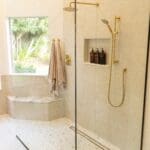Can Vinyl Flooring Be Used in a Bathroom Remodel?
Author: Thomas Borcherding | Updated On:
Why Consider Vinyl Flooring in a Bathroom?
Vinyl plank flooring, also known as luxury vinyl plank (LVP), is a phenomenal product. It has taken the residential and commercial building industry by storm. It can be produced with any finish desired, both in terms of texture and color. This is most commonly used to produce a wood-like vinyl plank.
Vinyl planks are easy to install, with most brands now offering a click-install system, where the seams click together. We always recommend using adhesive placed underneath the vinyl planks for better structural integrity. This prevents plank shifting. It also adheres the planks to the subfloor, which prevents cavities underneath the planks which make for an uncomfortable walking experience.
Vinyl flooring’s easy installation reduces labor expense. When combined with its already low cost per square foot, this makes vinyl flooring a great solution for budget-oriented shoppers who aren’t too concerned with obtaining an ultra-luxury bathroom.

Is Vinyl Flooring Waterproof And Able to Be Used in Bathrooms?
Vinyl, as a material, is non-porous and completely waterproof. However, this does not mean that every vinyl plank on the market is suitable for use in wet areas. The finish must also be waterproof, and the texture must not be slippery when wet.
Most brands of LVP consider themselves waterproof, although homeowners should always check to make sure their desired flooring is rated for use in wet areas.
Some brands go as far as saying that their vinyl flooring (and vinyl wall tile) can be used in the shower itself. This type of vinyl will most likely be considered Luxury Vinyl Tile (LVT), as opposed to what we’re discussing, Luxury Vinyl Plank (LVP).
We strongly recommend reviewing the manufacturer’s specification sheet, as this will tell you everything you need to know about water-rating and installation.
It’s Getting Late, Let’s Conclude
Vinyl flooring water-rating depends on the specific product, but it is most likely waterproof and suitable for use in your bathroom. You should ensure that the manufacturer has engineered the product so as to not be slippery when wet. The benefit of mimicking a wood grain is that the faux wood grain acts as a great slip-resistant, but verification from the manufacturer should still be obtained.
Most building products come with a specification sheet, which will outline installation instructions as well as water-rating. We hope this article has been helpful, and we wish you the best of luck with your bathroom remodel.
About the Author

Thomas Borcherding is a professional kitchen & bath designer, and a member of the National Kitchen & Bath Association (NKBA). He is the second-generation owner of Homestar Design Remodel, and takes great joy in providing those in St. Louis with high-quality, affordable home remodeling.








